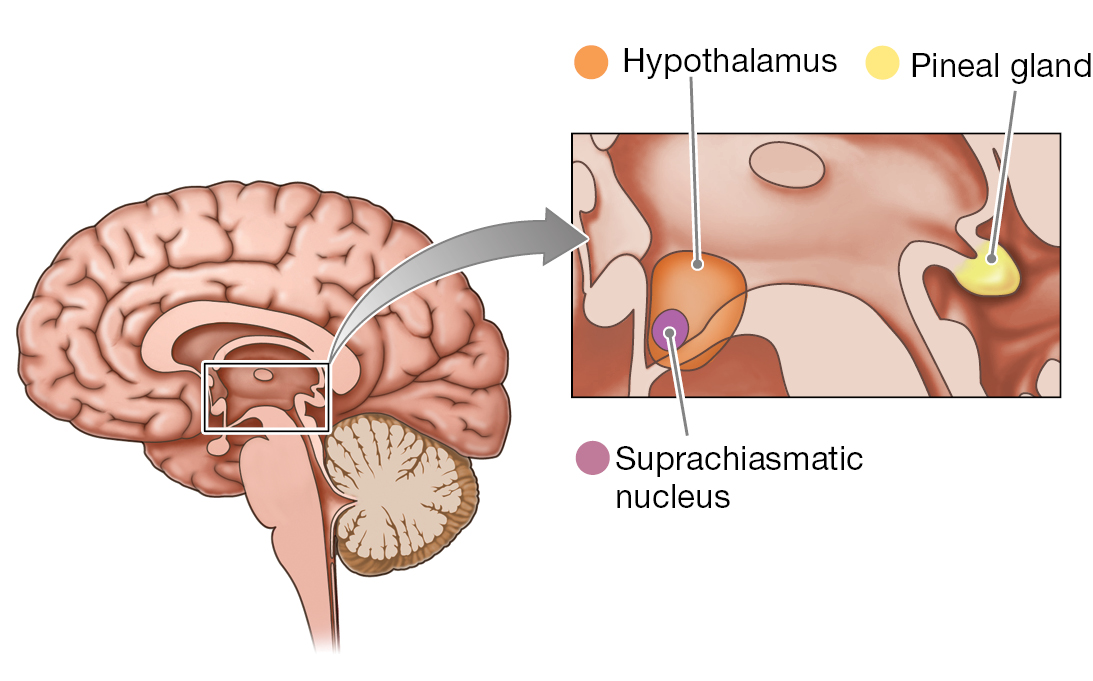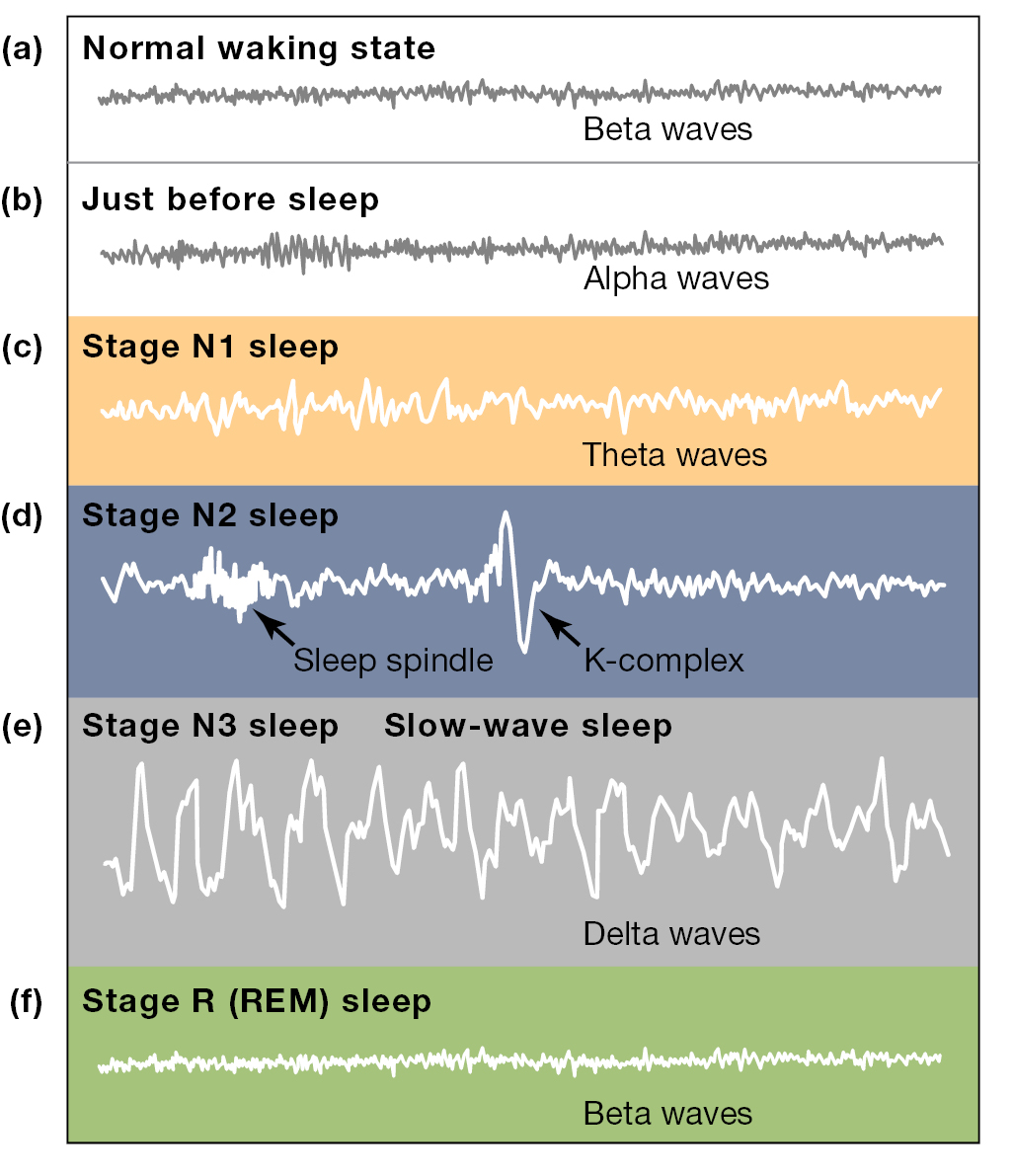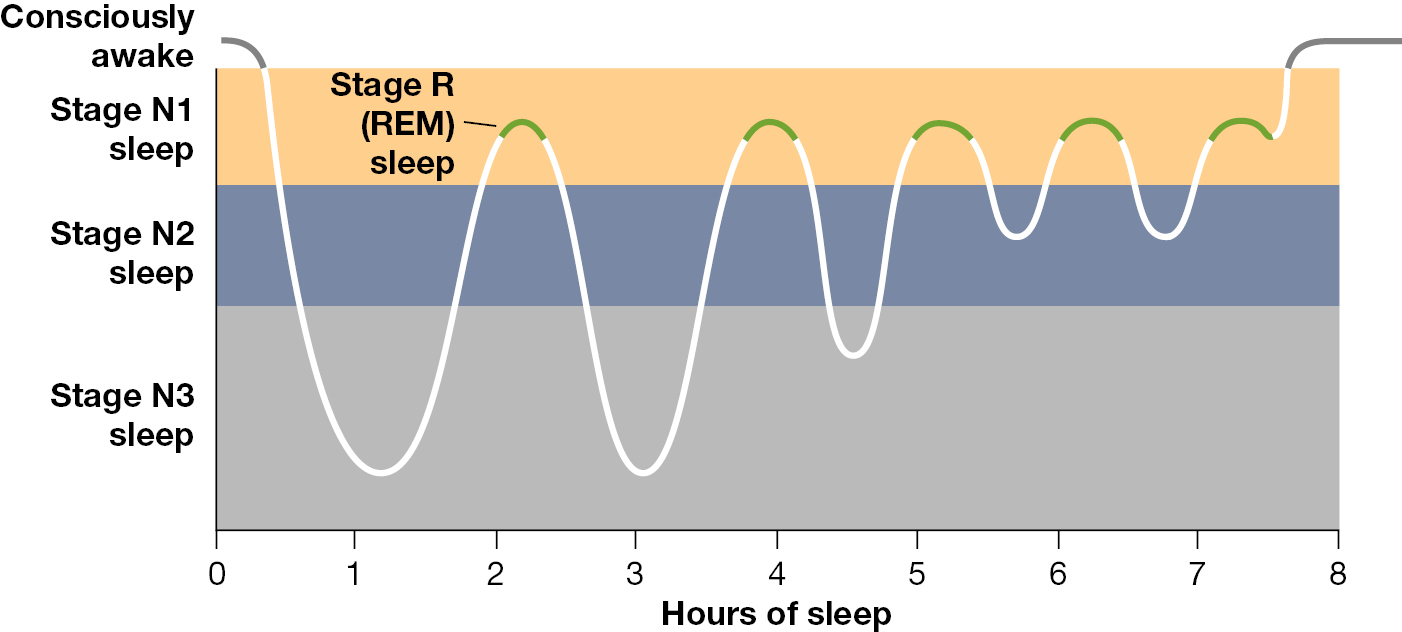LEARNING GOAL
Summarize the four stages of sleep.
LEARNING GOAL
Summarize the four stages of sleep.
Whether you are a night owl or an early bird, most days there will be a time when you feel sleepy and ready for bed. That sleepy feeling will most likely occur around the same hour each day because your body has an internal “clock” that regulates your sleeping and waking.
Sleep Is Part of the Normal Rhythm of Life Brain activity and other physiological processes are regulated into daily patterns known as circadian rhythms (circadian roughly translates to “about a day”). Sleep/wake cycles operate according to circadian rhythms, as do body temperature and hormone levels. Circadian rhythms are influenced by the cycles of light and dark. Even when removed from light cues, however, we continue to show these rhythms, as do nonhuman animals.
Multiple brain regions are involved in producing and maintaining circadian rhythms and your sleep/wake cycle. For instance, information about light detected by your eyes is sent to a small region of the hypothalamus called the suprachiasmatic nucleus (Figure 3.11). This region then sends signals to a tiny structure in the endocrine system called the pineal gland. The pineal gland influences the release of melatonin, a hormone that travels through the bloodstream and affects various receptors in the body, including some receptors in the brain. Bright light reduces the production of melatonin, whereas darkness triggers its release. Typical indoor lighting in the evening can cause a 50 percent decrease in melatonin, although people vary greatly in terms of how sensitive they are to light (Phillips et al., 2019). It is believed that melatonin helps regulate the accuracy of our biological clock. Taking melatonin as a dietary supplement can help people cope with jet lag and shift work, both of which interfere with circadian rhythms. Taking a melatonin supplement also appears to help people fall asleep, although it is unclear why this happens.

A section below the corpus callosum and above the pons in a sagittal view of the brain is enlarged in a close-up view. The hypothalamus and suprachiasmatic nucleus are located on the left side above the top of the pons.
FIGURE 3.11 Pineal Gland and Sleep/Wake Cycles
Changes in light register in the suprachiasmatic nucleus of the hypothalamus, which then signals the pineal gland. The pineal gland influences the production of melatonin, which signals the body that it is time to sleep or wake up.
Individuals differ tremendously in how much they sleep. Infants sleep much of the day. As adults, we spend about one third of our time sleeping, an average of around 8 hours per night. Some adults report needing 9 or 10 hours of sleep a night to feel rested, whereas others report needing only a few hours. People tend to sleep less as they age. However, researchers were skeptical when a 70-year-old retired nurse, Miss M., reported sleeping only about an hour a night—that is, until she agreed to participate in a study. On her first two nights in a research laboratory, Miss M. was unable to sleep, apparently because of the excitement. But on her third night, she slept for only 99 minutes, then awoke refreshed, cheerful, and full of energy (Meddis, 1977). You might like the idea of sleeping so little and having all those extra hours of spare time. But bear in mind that most of us do not function well on so little sleep.
Four Stages of Healthy Sleep How is being awake different from being asleep? The difference has as much to do with conscious experience as with biological processes. When you sleep, your conscious experience of the outside world is largely turned off. To some extent, however, you remain aware of your surroundings, and your brain still processes certain information. Your mind analyzes potential dangers, controls body movements, and shifts body parts to maximize comfort. This is why people who sleep next to children or pets tend not to roll over onto them and why, after infancy, most people do not fall out of bed while sleeping.
Before the development of objective methods to assess brain activity, most people believed the brain went to sleep along with the rest of the body. As you learned in study unit 2.4, the electroencephalograph (EEG) lets researchers measure the brain’s electrical activity. When you are awake and fully conscious in a normal waking state, you experience many different sources of sensory activity. As a result, the neurons in your brain are extremely active. An EEG shows this brain activity as short, frequent, irregular electrical signals called beta waves (shown in Figure 3.12a). When you really focus your attention on something, or when you close your eyes and relax, brain activity slows and becomes more regular, producing the electrical pattern known as alpha waves (Figure 3.12b).

The E E G patterns are all lines with sharp peaks and troughs. The first is titled, Normal waking state and shows beta waves. They have a very short wavelength and low amplitude. The second is titled, Just before sleep, and shows alpha waves. They have a very short wavelength, but the amplitude is slightly higher than beta waves. The third is titled, Stage N 1 and shows theta waves. They have an even longer wavelength with higher amplitude than alpha waves. The fourth is titled, Stage 2 and shows theta waves with a K-complex. A K-complex has a very high amplitude and wavelength but is within theta waves. The fifth is titled Stage 3 and 4 Slow-wave sleep, and shows delta waves. It has by far the highest amplitude and wavelength. The sixth looks almost exactly, like the first, as they both have beta waves, but this one is titled R E M.
FIGURE 3.12 Brain Activity Before and During Healthy Sleep
These EEG patterns are examples of electrical brain activity before sleep (a–b) and during the four stages of healthy sleep (c–f). Which stage involves sleep spindles?
As EEG readings indicate, sleep typically occurs in four stages (Figure 3.12c–f). These stages are marked by changes in consciousness. Sleep researchers also identify the stages of sleep by other bodily processes, such as rapid eye movement (REM) behind closed eyelids. For most of the night, your eyes do not engage in rapid eye movements, and so this type of sleep is called non-REM (NREM) sleep. When you start to drift off, you enter the first NREM phase of sleep, stage N1 sleep, shown on an EEG as slower theta waves (see Figure 3.12c). Your awareness of both the outer world and your inner mental activity starts to decline.
You can easily be aroused from stage N1 sleep. If awakened, you probably won’t be aware that you were drifting off. In this stage before true sleep, you might see fantastical images or geometric shapes. Or you might have the sensation of falling or that your limbs are jerking, a sensation called a hypnic jerk. Experts do not know exactly what causes hypnic jerks, but many believe that they come from the muscles responding to brain activity that occurs in stage N1 sleep. Because these jerks shift us briefly out of stage N1 sleep, we become aware that we just moved. This conscious awareness usually does not last long, though. It fades when we slip back into sleep for the night.
As you progress to stage N2 sleep, your breathing becomes more regular, and you become even less aware of the outside world and your inner mental activity. In this stage, you are truly asleep. Now the EEG shows large waves called K-complexes and occasional bursts of activity called sleep spindles (see Figure 3.12d). Abrupt noises can trigger K-complexes, which may be signals from brain mechanisms involved with shutting out the external world and keeping you asleep (Halász, 2016). As you will learn shortly, sleep spindles play an important role in memory.
The progression to deep sleep occurs in stage N3 sleep. This period is marked by large, regular delta waves, and it is often called slow-wave sleep (see Figure 3.12e). People in stage N3 are very hard to wake and are often disoriented when they do wake up. However, people still process some outside information in this slow-wave sleep because the mind continues to evaluate the environment for potential danger. For example, parents in slow-wave sleep can be aroused by their children’s cries. Yet those same parents can blissfully sleep through the sounds of sirens or traffic noise, which are louder than the crying children but are not necessarily relevant.
After about 90 minutes of sleep, the sleep cycle reverses, eventually returning to stage N1 sleep. At this point, the EEG suddenly shows a flurry of beta wave activity that usually represents an awake, alert mind. The eyes dart back and forth beneath closed eyelids. Because of these rapid eye movements, this stage is called stage R or REM sleep (see Figure 3.12f). It is sometimes called paradoxical sleep because of the paradox of a sleeping body with an active brain. Indeed, some regions of the brain are more active during REM sleep than during a normal waking state of consciousness. But although the brain is active during REM sleep, most of the body’s muscles are paralyzed. At the same time, the body shows signs of genital arousal: Most males of all ages develop erections, and most females of all ages experience engorgement of the clitoris.
REM sleep is psychologically significant because of its relation to dreaming. When people are awakened during REM sleep, about 80 percent of the time they report dreaming. By contrast, they report dreaming during non-REM sleep less than half the time (Solms, 2000). As you will see in the next study unit, you have different types of dreams during these two types of sleep.
The Repeating Sleep Cycle Over the course of a typical night, you cycle through the stages of sleep about five times. As Figure 3.13 shows, you first from stage N1 sleep to stage N2 sleep and stage N3 sleep, and then backward through the cycle to REM sleep. As morning approaches, the sleep cycle becomes shorter with little or no stage N3 sleep, and you spend relatively more time in REM sleep. You may say you slept like a log all night long, but that is probably not quite true. People briefly awaken many times during the night, although they do not remember these awakenings in the morning. As people age, they sometimes have more difficulty going back to sleep after awakening, and they spend less time in stage N3 sleep.

The line graph shows the stages of sleep over 8 hours. Within the first 2 hours the person goes from consciously awake to stage 1, stage 2, slow wave sleep, and then back up to where around 20 minutes of R E M sleep is reached in stage one but before wakefulness. This cycle repeats full-time again over 2 hours. After the second period of R E M, the person descends into stages 1 and 2 but only barely into stage 3/4 (slow wave sleep) before coming back up to R E M. The R E M period here is longer and the next decent only barely goes into stage two sleep before coming back up for another longer R E M period. This cycle is repeated once over an hour-long period. Then the cycle of going barely into stage two sleep is completed one more time, and instead of reaching R E M sleep, the individual reaches wakefulness.
FIGURE 3.13 Stages of Sleep
This chart shows how the four stages of sleep progress over the course of a night’s sleep.
![]() Stages of Sleep
Stages of Sleep
LEARNING GOAL CHECK: REVIEW & APPLY